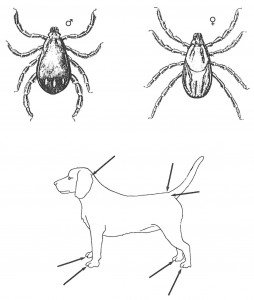
The female lays 2000-4000 eggs at a time. The eggs reddish-brown and are placed in clusters high up on the walls, in cracks or behind paintings. The hatching time of the eggs is 19-60 days. The small larvae are clear, active and have only six legs. They are similar in appearance to the adults. The larvae seek out dogs and suck blood in protected spots – for example inside the ears or between the pads. Once they have sucked blood for 3-6 days, they are bigger, light gray and almost spherical. They detach from their hosts and seek out a hiding place where they digest and develop into 8-legged nymphs.
Nymphs also suck the dog’s blood and detach from it, hide and develop into adult males or females. Females and males are active and are 3-5 mm long. Males only feed for short periods of time before searching for females that are ready to mate in the dog fur. While males retain their shape after mating, females are engorged. They stay latched to the dog’s skin for 6-50 days and continue to grow as the eggs develop in their bodies. Females that are ready to mate are blue-gray and nearly 1 cm long. They then crawl up walls to find suitable egg-laying sites.
Life cycle duration depends on factors such as temperature. In particularly hot environments there are a few months between the generations. In cold environments it takes longer. The brown dog tick cannot survive outdoors in the Danish climate. Indoors, it can live for 18 months without having to feed.




